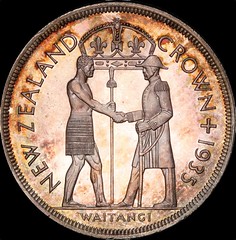
PREV ARTICLE
NEXT ARTICLE
FULL ISSUE
PREV FULL ISSUE
NEW ZEALAND'S 1935 WAITANGI CROWNA nice article on the Waitangi Crown by Andrew Crellin of Sterling & Currency in Fremantle, Western Australia was published in his October 2024 email newsletter. Great coin. Here's an excerpt - see the complete article online. -Editor The New Zealand 1935 Proof Crown, often referred to as the "Waitangi Crown", holds a unique place in numismatic history. This rare and sought-after coin commemorates the 95th anniversary of the signing of the Treaty of Waitangi, a landmark document that shaped the course of New Zealand's history. Struck in silver and with a limited mintage of just 1,128 coins, the Waitangi Crown is a prized possession for collectors and acts as a fascinating window into the country's past. In this article, we'll delve into the historical context surrounding the coin's creation, explore its design and specifications, and discuss its rarity, value, and appeal to both coin enthusiasts and history buffs. This treaty, signed on February 6, 1840, between representatives of the British Crown and over 500 Maori chiefs, established a unique relationship between the indigenous Maori people and the British settlers. The treaty aimed to ensure British sovereignty over New Zealand while guaranteeing Maori ownership and control over their lands, forests, and other possessions. In return, Maori were granted the rights and privileges of British subjects. What sets the Treaty of Waitangi apart from agreements in other colonized regions is its explicit recognition of indigenous rights and sovereignty. Unlike many instances where colonization led to the dispossession and marginalization of indigenous populations, the Treaty of Waitangi sought to establish a partnership between Maori and the British Crown. While the reality of its implementation has been complex and fraught with challenges, the treaty remains a foundational document in New Zealand's history and a symbol of the ongoing dialogue between Maori and the Crown. The design of the 1935 Proof Crown Waitangi's reverse evolved before arriving at the final version we know today. Initially, the New Zealand authorities, including the coin's advocate Allan Sutherland, favored a design by James Berry that depicted a group of Maori chiefs signing the treaty. However, this design was deemed too intricate for a coin by the Royal Mint's Standing Committee. The Committee then suggested a simplified design featuring just two figures: Lieutenant-Governor Hobson and Maori chief Tamati Waka Nene. Artist Percy Metcalfe was brought in, and he created a model inspired by Art Deco and Egyptian Revival styles. This design underwent several revisions based on feedback from New Zealand officials, including then-Minister of Finance Gordon Coates, who critiqued everything from the position of Hobson's leg to the size of Nene's hands and the accuracy of his cloak. Andrew adds: "Would anyone have an explanation of the composition of the mintage figures for both coins? I read and reread Stock's BNS paper several times to try to understand how the accepted figures have been compiled but was unable to do so. "I find the best way of getting feedback about an article is to publish it. :)" Can anyone help? -Editor
To read the complete article, see:
Wayne Homren, Editor The Numismatic Bibliomania Society is a non-profit organization promoting numismatic literature. See our web site at coinbooks.org. To submit items for publication in The E-Sylum, write to the Editor at this address: whomren@gmail.com To subscribe go to: https://my.binhost.com/lists/listinfo/esylum All Rights Reserved. NBS Home Page Contact the NBS webmaster 
|


